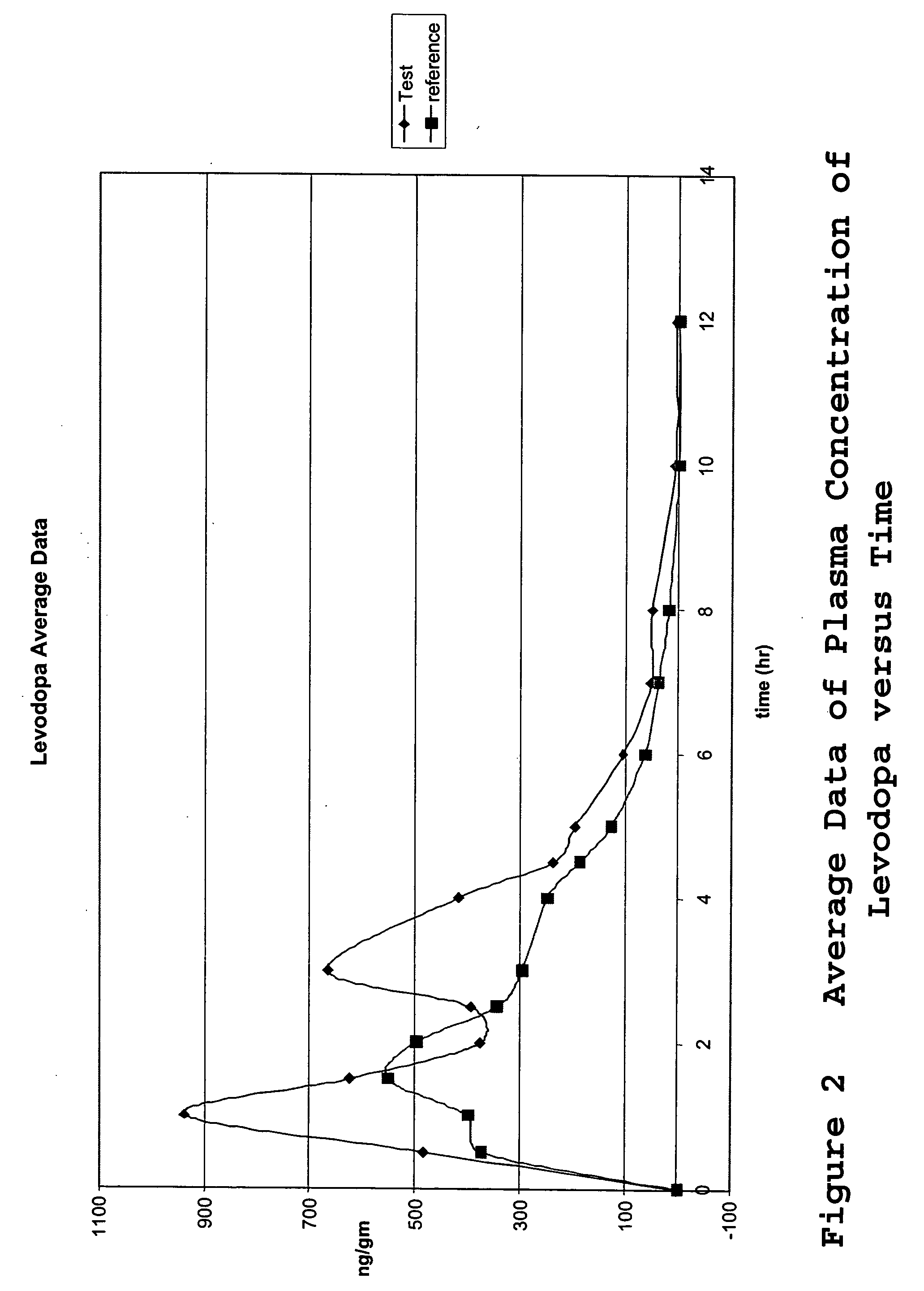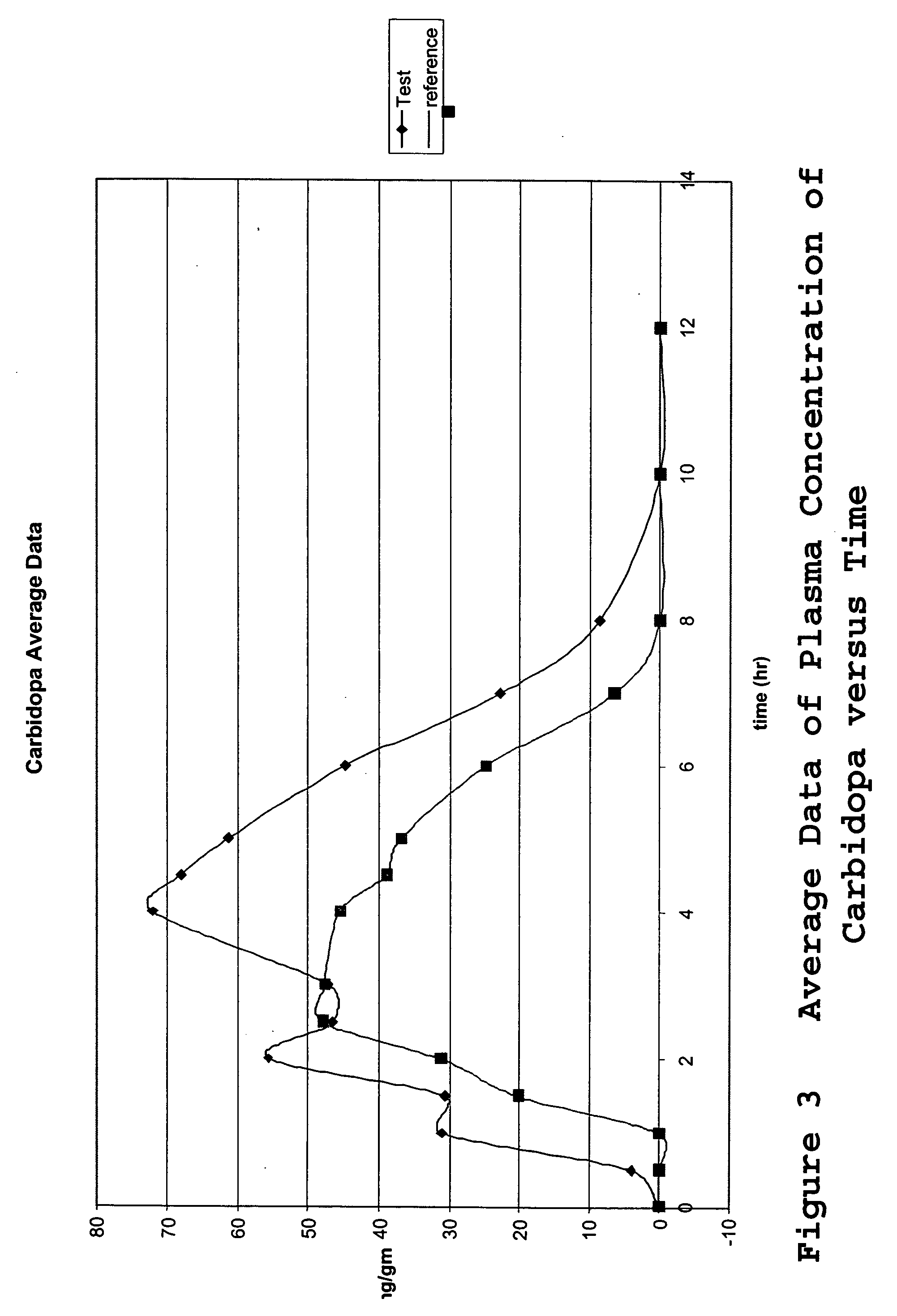Composition and dosage form for sustained effect of levodopa
a levodopa and sustained release technology, applied in the direction of biocide, drug composition, peptide/protein ingredients, etc., can solve the problems of delay between doses, not a cure, nausea in some patients, etc., to reduce the elimination of dopamine and avoid dyskinesia
- Summary
- Abstract
- Description
- Claims
- Application Information
AI Technical Summary
Benefits of technology
Problems solved by technology
Method used
Image
Examples
example 1
Enteric Coated Methylphenidate with an Annular Sheath of Levodopa and Carbidopa
[0055] An inner core in the form of a tablet was surrounded by an annular sheath as described below. The inner core was enteric coated methylphenidate and the annular sheath comprised levodopa and carbidopa.
[0056] The inner core was made first by making a granulate of methylphenidate, followed by forming a tablet and subsequently coating the tablet.
Methylphenidate Granulate:
[0057] Methylphenidate (150 grams), anhydrous lactose (420 grams), and hydroxypropylcellulose (Klucel LF™, 30 grams) were mixed in a Diosna P 1 / 6 high shear granulator at 380 rpm for 5 minutes. Purified water (60 grams) was added over the next minute while continuing to granulate at 380 rpm. The granulate was then massed for a further 10 seconds at the same speed. The formed granulate was dried for 30 minutes in a Diosna Mini Lab fluidized bed drier to less than 2% volatiles at an inlet temperature of 50° C. and a fan setpoint of ...
example 2
Drug Profile of the Tablet of Example 1
[0066] The tablets of Example 1 were tested to determine the drug release profile. The drug release was tested in an USP Apparatus II in 900 ml 0.1N HCl at 37° C. and 50 rpm for 3 hours and then pH=6.8 phosphate buffer for an additional 4 hours. At one hour intervals, the concentrations of methylphenidate, levodopa and carbidopa were measured by HPLC analysis. The results were summarized in Table 1 and illustrated in FIG. 1 for the drug release profile of the tablet of Example 1. The data demonstrated that the enteric coat prevented the methylphenidate from being released for the three hours that the system was in the acidic buffer. During the first three hours the majority of the levodopa (97.8%) and carbidopa (97.7%) was released. In contrast, none of the methlyphenidate was released over the first three hours. However, once the tablet was transferred to a neutral buffer, the methylphenidate was released over the following four hours to achi...
example 3
[0067] A single-center, randomized, open-label, 2-treatment, 2 sequence, 2 period, cross-over pharmacokinetic study was carried out to determine the in vivo drug release profile of the tablets. The study was designed and carried out as follows.
[0068]“Day 1” was designated as the day in which the drug treatment was administered. In each study, two days prior to Day 1, designated “Day (−2)” and “Day (−1),” respectively, an oral pre-treatment regimen of 50 mg (2×25 mg) carbidopa (Lodosyn®, 25 mg; Merck & Co., Inc.) was administered 3 times a day. Each subject received a total dose of 150 mg / day of carbidopa during the 2 days prior to Day 1, the study drug administration. The pre-treatment administrations were ambulatory.
[0069] Two treatments were administered in the study, the single test formulation of the invention of three separate drugs combined into one tablet (levodopa, carbidopa, and methylphenidate) and a control consisting of two different tablets ...
PUM
| Property | Measurement | Unit |
|---|---|---|
| Time | aaaaa | aaaaa |
| Time | aaaaa | aaaaa |
| Time | aaaaa | aaaaa |
Abstract
Description
Claims
Application Information
 Login to View More
Login to View More - R&D
- Intellectual Property
- Life Sciences
- Materials
- Tech Scout
- Unparalleled Data Quality
- Higher Quality Content
- 60% Fewer Hallucinations
Browse by: Latest US Patents, China's latest patents, Technical Efficacy Thesaurus, Application Domain, Technology Topic, Popular Technical Reports.
© 2025 PatSnap. All rights reserved.Legal|Privacy policy|Modern Slavery Act Transparency Statement|Sitemap|About US| Contact US: help@patsnap.com



